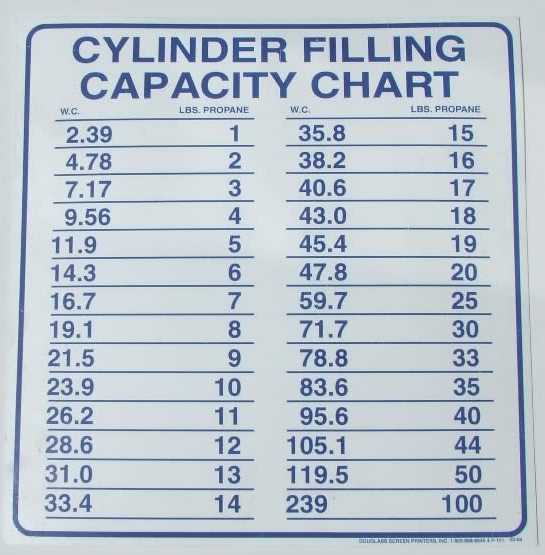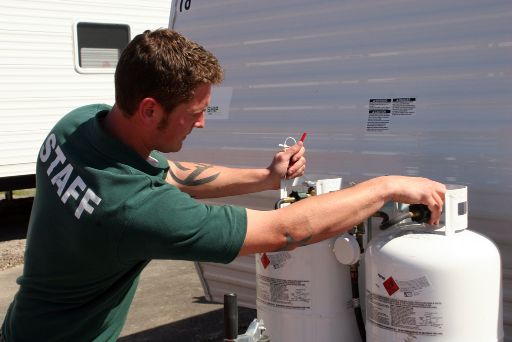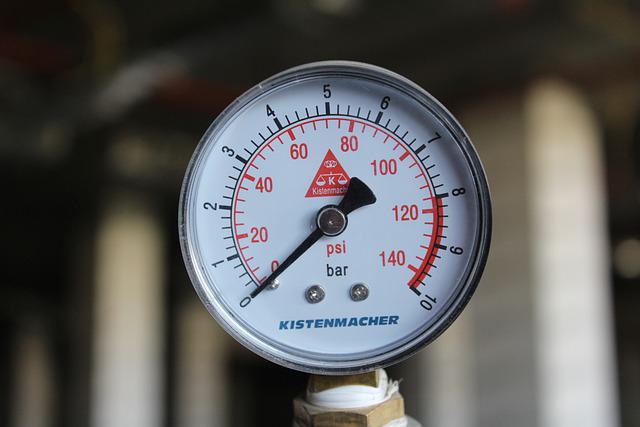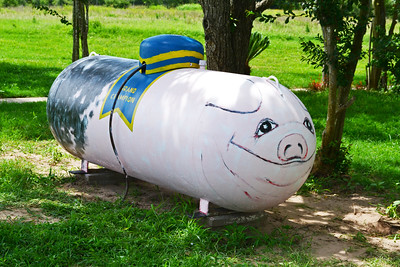
If you have a propane cylinder at your home, you may have noticed the letters “WC” stamped on the side. You may be wondering what does this marking mean on propane tank. WC stands for water capacity. This is the amount of liquid that the tank can hold. The average propane tank can hold about 250 gallons of water.
Propane is liquid when compressed, it turns into gas when released from the tank. The WC stamped on the collar of the tank indicates the maximum capacity the tank can contain.
When refilling propane tank, the gauge may read just 80% of the capacity because doing so gives enough room for the propane to expand inside the tank.
Read related article: Which Propane Tanks Can Be Refilled (How to Identify)
What is propane tank water capacity (WC)
The water capacity of a propane tank refers to the amount of liquid that the tank can hold. This is an important factor to consider when selecting a propane tank, as a larger tank will be able to hold more fuel and provide a longer-lasting supply of propane. The water capacity of a propane tank is typically measured in gallons.
The water capacity of a propane tank can vary depending on the size and type of tank. For example, a small, portable propane tank may have a water capacity of 20 gallons, while a larger, stationary tank may have a water capacity of 500 gallons or more. The water capacity of a propane tank is typically marked on the tank itself, so you can easily determine how much fuel it can hold.
In general, the larger the propane tank, the higher its water capacity will be. Larger tanks are typically more expensive, but they provide a longer-lasting supply of propane and can save money in the long run by reducing the need for frequent refills.
It is important to choose the right size propane tank for your needs, taking into account factors such as the size of your home, your heating and cooking needs, and the availability of propane refill services in your area.
[table id=3 /]
How to read propane tank markings
The collar of a propane tank has various markings that provide important information about the tank. To read these markings, you will need to understand the meaning of the various symbols and abbreviations used. Some common markings that you may find on the collar of a propane tank include:
- WC: This stands for “water capacity” and indicates the maximum amount of water that the tank can hold. This is typically measured in gallons.
- TW: This stands for “tare weight” and indicates the empty weight of the tank. This is the weight of the tank when it is empty, and it is typically measured in pounds.
- Serial number: This is a unique identification number that is assigned to the tank by the manufacturer. It is used to identify the tank and track its use and maintenance history.
- Manufacture date: This indicates the date when the tank was manufactured. It is typically marked as a four-digit year, such as 2021.
- Maximum pressure rating: This indicates the maximum pressure that the tank is designed to withstand. It is typically marked in pounds per square inch (psi).
- DOT: This stands for “Department of Transportation” and indicates that the tank meets the safety standards set by the U.S. Department of Transportation.
By understanding the meaning of these markings, you can easily read the collar of a propane tank and learn important information about the tank. If you are unsure about the markings on your propane tank, it is best to consult the manufacturer’s instructions or contact a qualified technician for assistance.
Read related article: Can You Exchange a Non-OPD Valve Propane Tank?
The Importance of ‘WC’ on Propane Tanks for Safety
Have you ever noticed the “WC” marking on a propane tank and wondered what it means? It stands for Water Capacity. Let’s see why it’s so essential for your safety.
Why do you need to know the water capacity?
- No Overfilling: Think of the tank like a water bottle. You can’t fill it up to the very top because when propane gets hot, it needs some space to expand. The water capacity tells you how much water the tank can hold, but with propane, you only fill it up to 80% of that. This prevents overfilling and keeps things safe.
- Keeping the Tank Safe: If you put too much propane in the tank, it might damage the tank because of the extra pressure. By knowing the water capacity, you make sure the tank stays in good shape.
- Safe Travels: If you’re moving the tank somewhere, knowing its water capacity helps you figure out how heavy it’ll be when filled. This ensures it’s safe to transport.
- Quick Help in Emergencies: In case something goes wrong, emergency workers can use this mark to guess how much propane might leak out. This helps them act fast and effectively.
How can knowing the ‘WC’ stop bad things from happening?
- Avoid Overflows When Refilling: Sometimes, tanks get filled too much, leading to leaks or even bursts. If you’re aware of the water capacity, you can make sure this doesn’t happen.
- Storing Safely in Hot Weather: In hot places, propane inside the tank expands. If you’ve filled the tank close to its water capacity, it might be too much in high heat. Keeping an eye on this mark ensures you store your tank safely.
- Safe on the Road: Imagine a tank filled more than it should be, and then there’s a car accident. That’s a risky situation! By respecting this mark, you reduce this risk.
- Correct Readings in Cold Places: In cold areas, even if the tank is full, the pressure might seem low. But if you know the WC, you won’t be fooled and can avoid overfilling.
So next time you see this mark on a propane tank, remember it’s not just a random marking. It’s a guide to help you use and handle the tank safely. Always keep it in mind! To learn more about related rules, read this.
Read related article: Can I Exchange Old Propane Tank?
Water capacity of propane tank for residential use
The water capacity of a propane tank for residential use can vary depending on the size and type of propane tank. The most common type of propane tank for residential use is the 500-gallon tank. These tanks are typically made of steel and have a capacity of 500 gallons (1,893 L).
Some 500-gallon tanks may be made of fiberglass, which will decrease the weight of the tank but will not decrease the overall water capacity. 500-gallon propane tanks are the most common size used for residential purposes. They are typically used to power furnaces, water heaters, dryers, and stoves. Each appliance uses a different amount of propane, so it is important to know how much your appliances use before selecting a propane tank size.
The water capacity of a propane tank is an important factor to consider when selecting a propane tank for residential use. A larger tank will be able to hold more fuel and provide a longer-lasting supply of propane. This can save money in the long run by reducing the need for frequent refills.
When choosing a propane tank for residential use, it is important to consider factors such as the size of your home, your heating and cooking needs, and the availability of propane refill services in your area. It is also important to consider the size and weight of the tank, as well as its location and the ease of access for refills and maintenance.
If you are unsure about the size and water capacity of the propane tank that is best for your home, it is best to consult a qualified technician for assistance. They can help you select the right size tank for your needs and ensure that it is installed and used safely and properly.
| Size Category | WC Value Description | Importance of WC |
|---|---|---|
| Small Canisters | Portable tanks for grilling or camping. WC values reflect volumes typically ranging from 1 lb to 20 lbs of propane capacity. | Ensures you won’t overfill a small canister. Helps estimate usage duration for activities like camping. |
| Medium-sized Tanks | Used for home heating or cooking, holding between 100 to 500 gallons of propane. WC values will indicate a slightly higher volume for water. | Helps in selecting the right tank size for home use, ensuring safety and efficient usage. |
| Large Commercial Tanks | Large tanks for businesses or industrial sites with WC values indicating capacities from 1,000 to 30,000 gallons of propane or more. | Allows businesses to make cost-effective decisions. Ensures proper storage and handling procedures are followed for large volumes. |
Common Misconceptions about the Marking
“WC means the amount of propane the tank can hold.”
Truth: Nope! “WC” stands for Water Capacity. It shows how much water the tank can hold, not propane. When it comes to propane, you only fill the tank to about 80% of its water capacity to keep things safe.
“A higher WC means the tank is safer.”
Truth: A higher water capacity doesn’t necessarily mean the tank is safer. Safety depends on the tank’s design, material, and how it’s used. The water capacity just tells you its volume, not its safety level.
“If the tank’s WC is full of propane, it’s okay.”
Truth: This is risky! Filling the tank up to its water capacity with propane doesn’t leave room for the propane to expand when it gets warm. This can lead to dangerous pressure build-ups.
“WC tells you how much propane is left in the tank.”
Truth: Not really. The water capacity just gives a total volume. To know how much propane is left, you’d need a gauge or a weight comparison.
What ‘WC’ Does NOT Indicate About a Propane Tank:
- Tank’s Age or Quality: Just because a tank has a WC marking doesn’t mean it’s new or of high quality. Always check other labels or manufacturing dates to determine the tank’s age.
- Tank’s Safety: As mentioned above, the WC doesn’t tell you if the tank is safe. Always get your tanks checked regularly and use them as recommended.
- Type of Gas Inside: The WC doesn’t tell you what kind of gas is inside. It could be propane or something else. Always check other labels to be sure.
- Tank’s Pressure Level: WC is all about volume, not pressure. To understand the pressure inside the tank, you’d need to look at the pressure gauge.
So next time you’re dealing with a propane tank, remember that the marking is there to guide you on volume, not to tell the whole story. Always handle with care, and if in doubt, ask an expert!
Safety Tips Related to WC (Water Capacity) and Propane Tanks
When dealing with propane tanks, safety should always be a top priority. Understanding the “WC” or Water Capacity marking on your propane tank is an essential part of this. Here’s how you can ensure safe usage:
1. Fill Only Up to 80% Capacity
- Why This Matters: Propane expands when the temperature rises. By leaving space, you allow for this expansion and avoid creating too much pressure inside the tank.
- What You Should Do: When you’re getting a refill, make sure the service provider knows the WC and doesn’t fill beyond the 80% mark.
2. Regularly Check Your Tank for Integrity and Potential Leaks
- Why This Matters: Tanks can corrode or get damaged over time, leading to propane leaks.
- What You Should Do: Use a soapy water solution to spot leaks – if propane is escaping, bubbles will appear. Also, give your tank a visual once-over for any signs of dents, rust, or wear.
3. Store Your Tank in a Well-Ventilated Area, Away from Open Flames
- Why This Matters: Propane is flammable. A leak in a confined space can be dangerous if the gas builds up.
- What You Should Do: Keep your propane tank upright and in a cool, shaded place. Avoid storing it in enclosed areas like your basement or garage. Make sure it’s also distanced from ignition sources like grills or heaters.
Additional Safety Tips for You:
- Transport Your Tank with Care: When moving your tank, keep it upright and make sure it’s secured to prevent rolling or jostling. And remember, don’t leave it in a hot car or trunk.
- Recognize the Odor of Propane: Propane has a specific smell, similar to rotten eggs, for safety reasons. If you catch a whiff, it might mean there’s a leak. Turn off any open flames, shut off the gas if it’s safe, and then get to a safer location before calling for help.
- Update Outdated Tanks: Check the expiration date on your propane tank. If it’s old or expired, consider getting it replaced or re-certified to meet current safety standards.
- Choose Light Colors if Painting Your Tank: Light colors reflect sunlight, while dark ones can cause the tank to absorb heat and potentially increase pressure inside.
By keeping these guidelines in mind and being proactive about understanding the WC and other markings on your propane tank, you’re taking important steps toward ensuring a safe experience.
Understanding Markings on Your Propane Tank
Your propane tank has several markings that provide key information. Let’s break down what these markings mean for you:
Date of Manufacture
- What It Tells You: This is the tank’s “birthday” – the day it was made.
- Why You Should Care: Tanks last about 10 to 12 years. If yours is older, it might be time for a replacement or check-up.
Inspection Dates and Certifications
- What They Show: The dates your tank was checked for safety and any approval stamps it received.
- Why You Should Care: If it’s been a while since the last check, your tank might need another inspection. Also, look for legit certification stamps to ensure your tank meets safety standards.
Maximum Allowable Working Pressure (MAWP)
- What It Tells You: The highest pressure your tank can safely handle.
- Why You Should Care: To prevent overloading and possible tank damage, make sure your tank’s pressure doesn’t go above this limit, especially in changing temperatures.
Quick Tip:
- Always pay attention to these markings. They’re there for your safety and to help you get the best use out of your propane tank. If you’re ever unsure about what a marking means, ask an expert or do a quick search. Safety first!
To summarize this
Now that you no longer wonder what does WC mean on propane tank, you now have the knowledge to choose the right size of tank for your application. Water capacity is one of important factors when purchasing tanks for your home use.

Mike is an experienced propane technician with over 15 years of professional experience in the field. He has dedicated his career to helping customers with their propane needs, from installation to maintenance and repair. Together with Jeremy, he co-founded this website to provide useful information and guidance to customers seeking reliable propane services.



